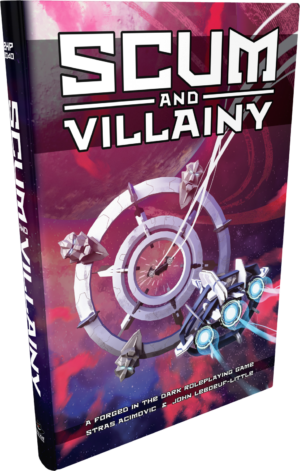Scum and Villainy Science Fiction; Space Opera; Bleak; Forged in the Dark (FitD); Resource Management; Heist; Team-Based
Scum and Villainy is a Forged in the Dark tabletop roleplaying game that plunges players into a dark, post-apocalyptic, and narrative-driven world. Set in the Procyon Sector under the oppressive Galactic Hegemony, players take on the roles of daring scoundrels trying to make a living among powerful criminal syndicates, warring noble families, dangerous aliens, and strange mystics. Rooted in the Powered by the Apocalypse (PbtA) system, it emphasizes collaborative worldbuilding and narrative-focused gameplay, offering a bleak yet engaging experience for players who enjoy high-stakes adventures in a space opera setting. The game distinguishes itself with its focus on action and minimal planning, utilizing mechanics like flashbacks to streamline gameplay and keep players immersed in the story.
Theme and Setting
Scum and Villainy is set in the Procyon Sector, a region far from the galactic center under the control of the iron-fisted Galactic Hegemony. The game evokes a gritty, space-western feel reminiscent of Firefly or Fantasy Flight's Edge of the Empire, but with a darker edge. Players inhabit a universe filled with criminal syndicates, warring factions, and the ruins of lost civilizations, creating an atmosphere of desperation and opportunity. The game setting provides a rich tapestry for collaborative worldbuilding, inviting players to contribute to the sector's lore and create their own unique stories within it. The setting also includes the mysterious "Way," analogous to magic or the Force, adding a layer of the arcane to the science fiction backdrop.
Core Mechanics and Rules
Scum and Villainy uses the Forged in the Dark system, derived from Powered by the Apocalypse. The core mechanic involves rolling a pool of d6 dice, where a 6 indicates a full success, 4-5 a partial success (success with complications), and 1-3 a failure. The number of dice rolled depends on character skills and external factors like assistance from other players or Devil's Bargains. The game emphasizes narrative over meticulous planning; players are thrust into action immediately, using flashbacks to retroactively establish preparations and solutions.
The position (Controlled, Risky, Desperate) and effect (Limited, Standard, Great) are determined by the GM and player negotiation, setting the stage for the consequences of success or failure. The position indicates the risk involved in the action, while the effect indicates the degree of success. Downtime activities between jobs allow characters to reduce stress, upgrade their skills and ship, and manage entanglements with rivals and the law. The game also utilizes clocks to track progress, threats, or long-term projects.
What Makes It Unique
Scum and Villainy distinguishes itself through its emphasis on streamlined gameplay and narrative control. Unlike many tabletop RPGs, it minimizes pre-planning, relying on the flashback mechanic to introduce solutions on the fly. This keeps the focus on action and improvisation. The collaborative nature of worldbuilding and the GM's role in facilitating the story rather than dictating it creates a dynamic and engaging player experience. The game's structure, which encourages players to embrace chaos and lean into the consequences of their actions, sets it apart from more traditional, goal-oriented RPGs.
Ship character sheets also provides unique advancement opportunities allowing for the player to develop their ship alongside their characters
Target Audience and Player Experience
Scum and Villainy is designed for players who enjoy narrative-driven, collaborative storytelling and high-stakes action. The game appeals to those who appreciate a space opera setting with a darker edge. The PbtA system and the Forged in the Dark mechanics make it accessible to both experienced and novice roleplayers. The game creates a player experience of being a ragtag crew barely surviving in the sector, but eventually developing into a well-known and dangerous force to be reckoned with.
While some find the game's mechanics unintuitive and recommend the GM be familiar with Forged in the Dark TTRPGs, many others describe it as functionally simple, deceptively elegant, and narrative focused.


